Hachee (Dutch Beef & Onion Stew)
This post may contain affiliate links. See my disclosure policy.
Hachee is a traditional beef and onion stew found in virtually every Dutch home. It’s a delicious comfort dish to enjoy during the cold winter months. The long, slow cooking time produce super tender meat and a rich sauce with wonderful depth of flavor. This authentic hachee recipe is one the whole family will love!
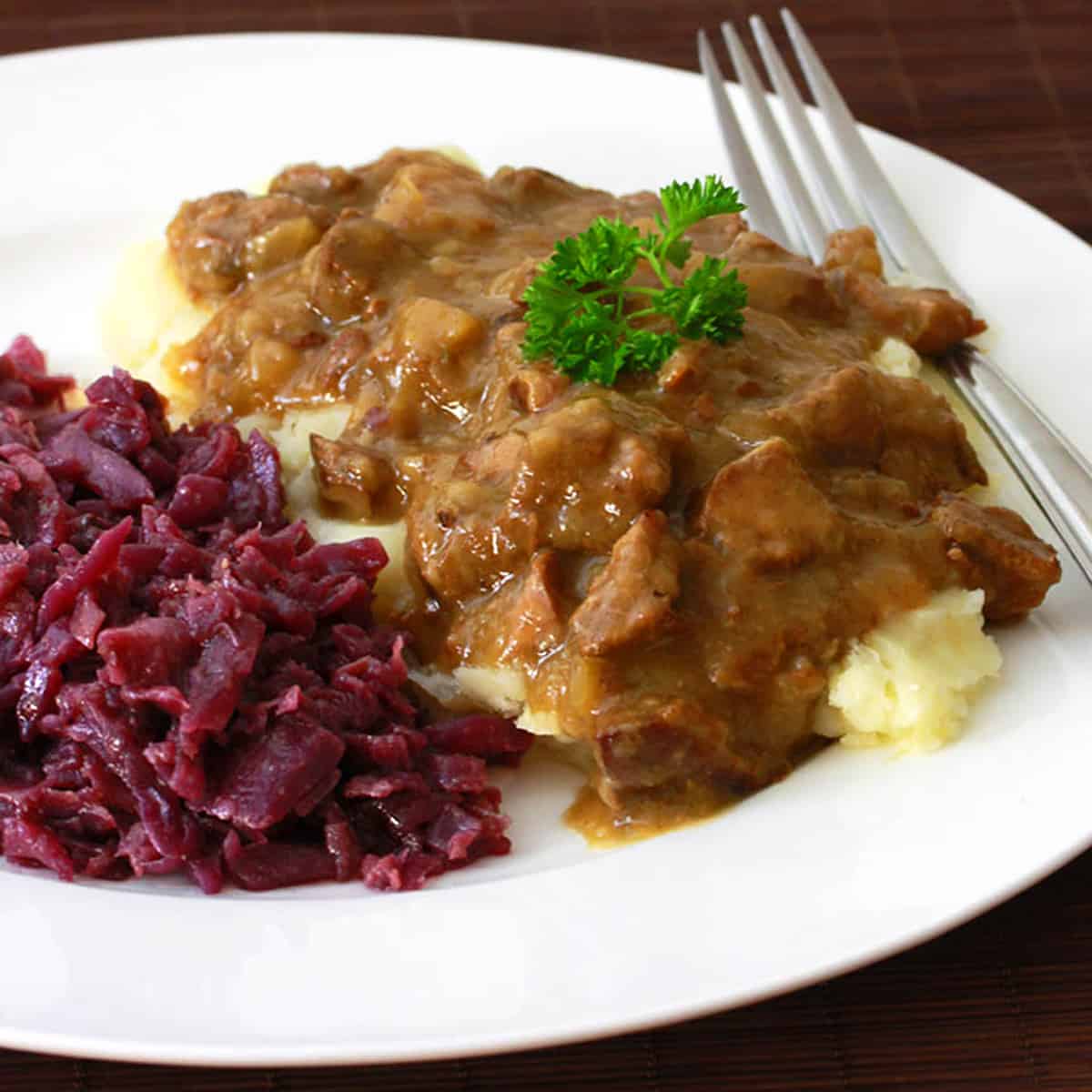
What is Hachee?
The word hachee has its origins in the French hacher, meaning “to chop” and Hachee is sometimes referred to as a “hash.” Hachee has been around since the middle ages and like many of the traditional dishes of Europe that we know and love today, it was originally a peasant dish, created as a means of using up leftover meat and vegetables. The vinegar was used to tenderize tough pieces of meat, much like the French used wine in Coq Au Vin). Less expensive vegetables likes onions were used in generous amounts. A long cooking process further ensured the meat would be tender. Hachee remains a popular and much-loved dish in the Netherlands. So much so that you can find it ready-made in grocery stores. But nothing beats homemade, and your patience in the long, slow cooking process will yield results that will make your taste buds swoon.
Traditional Seasonings in Hachee
The flavor profile of Hachee is significantly different from the traditional beef stews we know here in the U.S.. Hachee uses equal parts of beef and onion and the onions are caramelized. The featured flavors in this stew are cloves, juniper berries, black peppercorns, bay leaves and vinegar – all of which come together to provide a wonderful depth of flavor that is both rich and comforting. The flavor of Hachee shares similarities with German Sauerbraten.
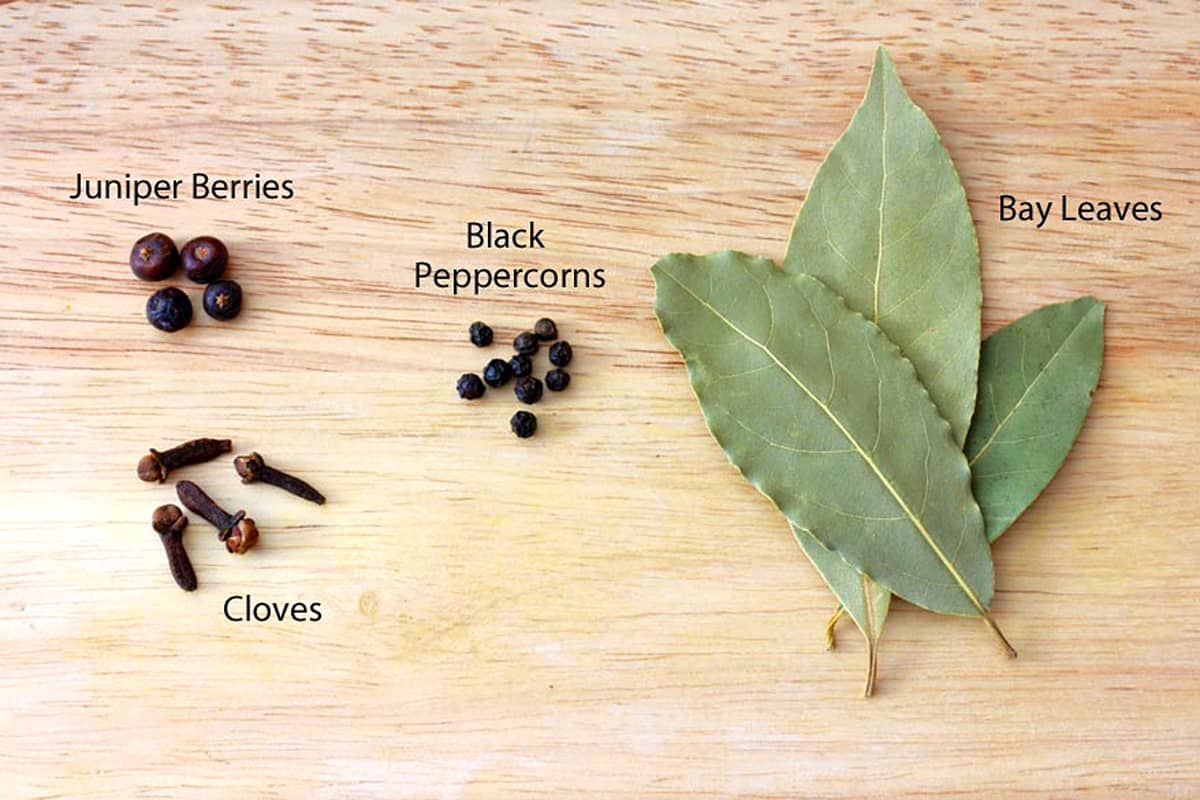
I first made this recipe over 10 years ago when my husband’s family came for a visit. My father-in-law had lived in the Netherlands for a while as a young adult and fell in love with the country, its people, and its food. Many of the dishes he enjoyed there over 40 years ago he hadn’t had since, and he has often mentioned longing to enjoy them again. So I wanted to surprise him with a traditional Dutch meal. I narrowed it down to three options: Boerenkool Stampot, Hutspot, and Hachee. I decided on Hachee. It’s a little more interesting, plus you can’t find the smoked Dutch sausages (rookworst) here that are traditionally eaten with the other two dishes. And it also gave me the excuse to finally make the braised red cabbage with it that many of my readers had been requesting – a side dish that is equally popular in Germany where it is known as Rotkohl.
As my father-in-law sat down to dinner he instantly recognized the dish. “This is the dish I had almost every night during my first two months in the Netherlands!” It was the first time he had had it in over 40 years and he savored every bit. We all did.
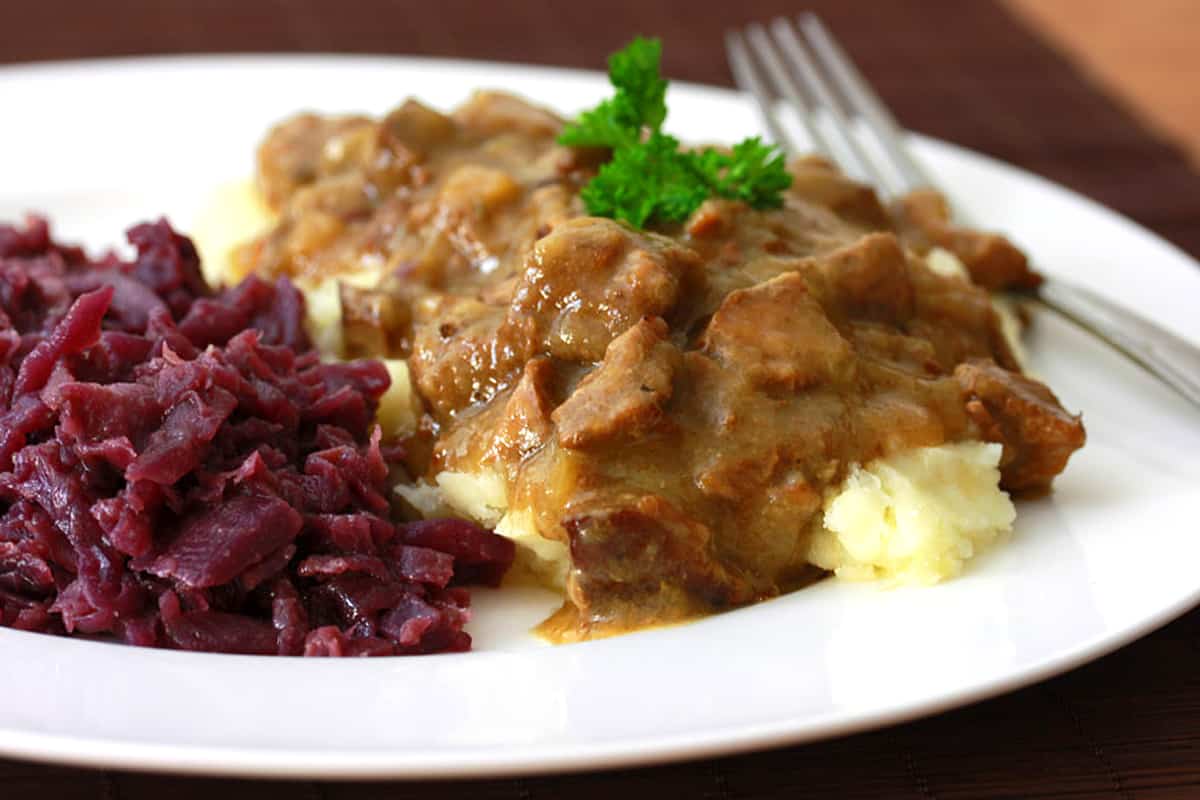
Hachee Recipe
Let’s get started!
Cube the beef and pat it dry with a paper towel – this will ensure that it browns well. Sprinkle with a little salt and pepper.
Brown the beef in a Dutch oven. Brown the cubes on all sides. Brown in batches so as not to overcrowd the beef – that will prevent it from browning properly. Remove the beef and set aside, leaving the burnt bits on the bottom of the pan – those will provide a lot of flavor to the stew.
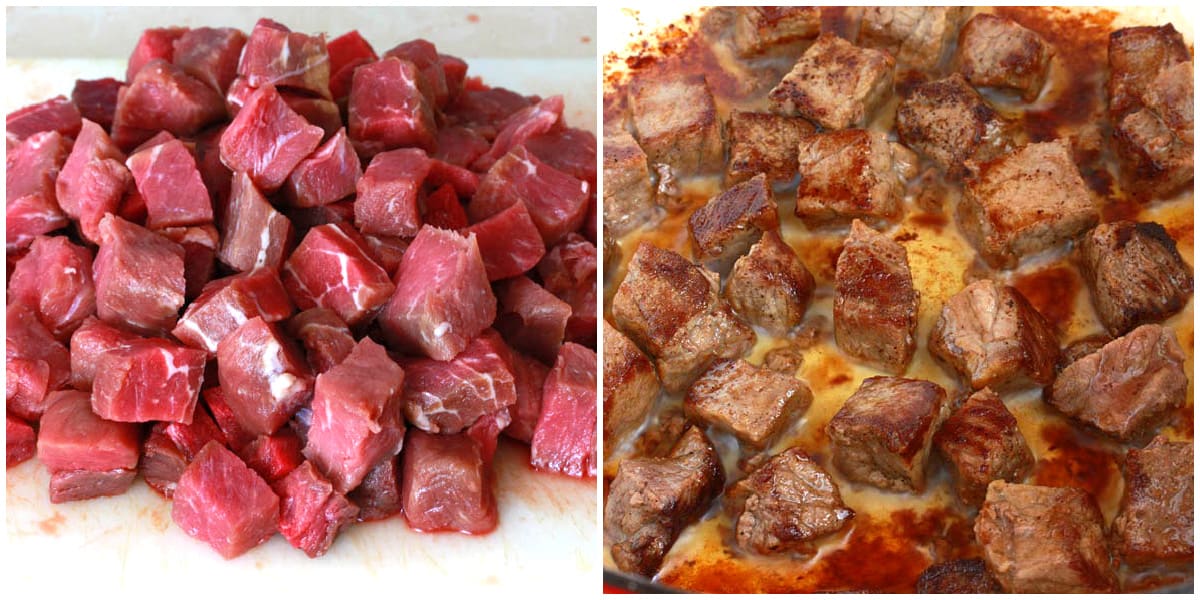
Add some more butter and caramelize the onions until golden brown. Add the flour and stir to combine.
Add the beef to the onions.
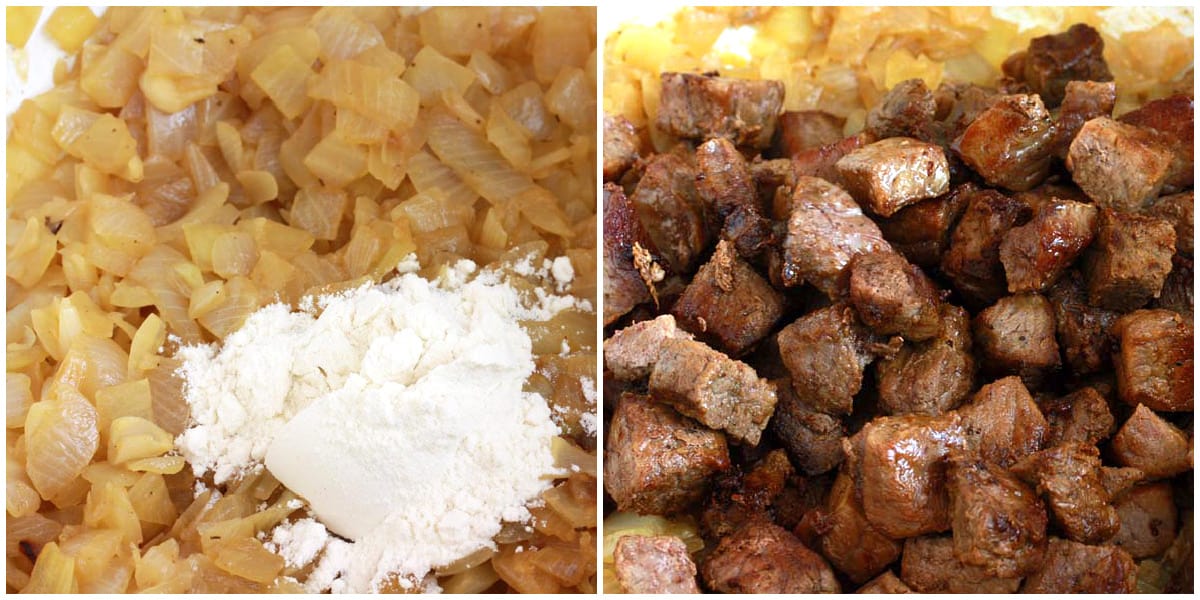
Add the beef broth and the seasonings. Bring to a boil, reduce the heat to low, cover and simmer for 2 1/2 hours. Uncover and simmer for another 30 minutes to help thicken the sauce. If it needs further thickening, make a slurry with equal parts of flour and water and stir it into the stew, stirring constantly to prevent lumping. Return to a simmer until the stew is thickened.
Add salt, pepper and more red wine vinegar to taste.
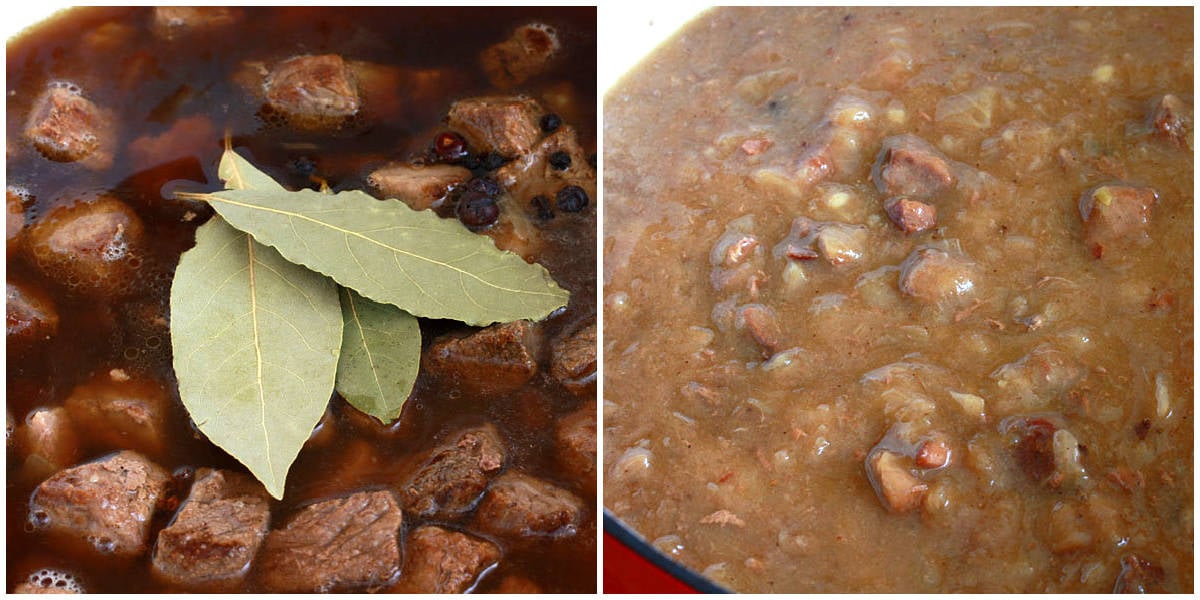
Hachee is traditionally served with aardappelen (potatoes) and rode kool met appeltjes, which is braised red cabbage with apples, also known as Rotkohl in German. A serving of applesauce is also common.
Eet smakelijk!
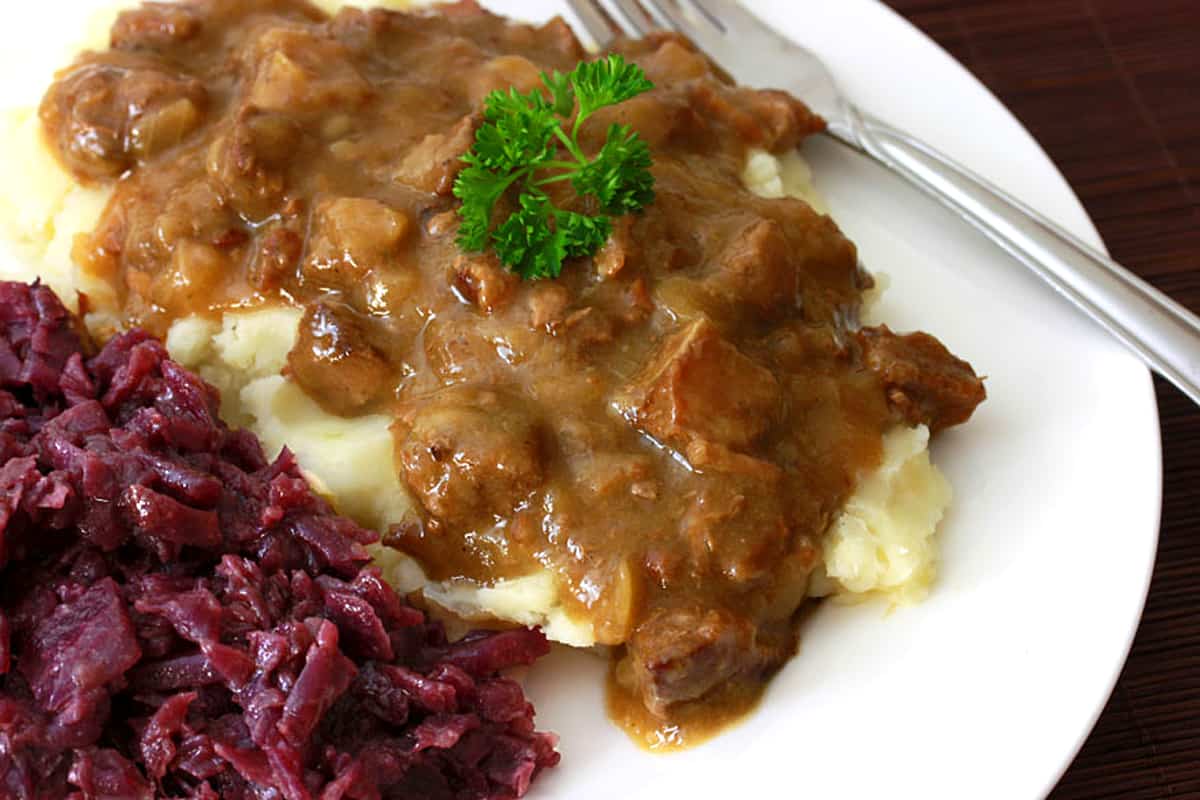
For more delicious beef stews from around the world be sure to try my:
- Swedish Kalops
- Hungarian Goulash
- Guinness Stew
- Pörkölt
- Beef Bourguignon
- Sega Wat
- Old Fashioned Beef Stew
- Domoda
- Szegedin Goulash
Save This Recipe
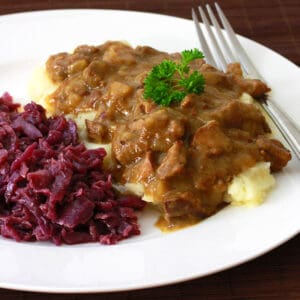
Hachee (Dutch Beef & Onion Stew)
Ingredients
- 2 pounds stewing beef (e.g. chuck) , cubed in 1/2 in. pieces, blotted dry with paper towel, lightly seasoned with salt and pepper
- 3 tablespoons butter
- 2 pounds yellow onions , about 4 large, finely chopped
- 1/4 cup all-purpose flour
- 4 cups good quality beef broth or stock
- 3 large bay leaves
- 4 cloves
- 4 juniper berries
- 10 black peppercorns
- 2 tablespoons red wine vinegar
- 3/4 teaspoon salt
- 1/4 teaspoon freshly ground black pepper
Instructions
- Melt the butter in a Dutch oven over medium-high heat. Brown the beef on all sides, working in batches so as not to overcrowd. Transfer to a plate and set aside. Leave the browned bits in the pan (important for flavor).Add the onions and some more butter if needed and cook until caramelized, about 25 minutes. Add the flour and stir until combined. Add the beef to the onions, stir to combine, and cover with the beef stock just until covered. Add the seasonings and red wine vinegar, stir to combine.Increase the heat and bring the stew to a boil. Reduce the heat to low, cover, and simmer for 2 1/2 hours. Uncover and simmer for another 30 minutes to further thicken the stew. Add salt, pepper and more red wine vinegar to taste. Discard the juniper berries, cloves, and bay leaves. Leave in or discard the peppercorns.Serve with mashed potatoes and braised red cabbage.
Nutrition
Originally published on The Daring Gourmet January 6, 2014



















No! what a shame for your dish! Flour is packed with gluten. Just leave it out you don’t need that, use a glass of red wine instead. Flour is a way of cheating and super unhealthy even if you can stand gluten, your basically add glue to your nice pieces of meat. Worried of not thickening, it will without it takes a bit longer.
Can you use ground cloves instead of whole cloves? If so, what would be the proper amount for ground cloves? Thanks!
Hi Rebekah, yes you can. I’d aim for around 1/4 teaspoon, maybe slightly less.
My absolute favourite meal as a young child in Holland, and still is as an adult. A pot is simmering as I enter this comment, yes delicious recipe
Oh my days, and my nights! For so many reasons, this little find turned out to be one of my biggest successes thus far – and I have been knowing how to cook at home for the best part of a decade or more. Where this was a gamble turned into great investment came about with cooking for my nieces and their dad – it paid off in the end.
I had a rare day when I wasn’t signed up at work (albeit volunteer), so I could focus on the kind of cooking that I love doing the most—the slow food movement. I enjoy watching the progress of how a gravy thickens, how an onion caramelises, and how meat goes from leather to butter. I am in control of it the whole way.
What was additionally so good about it was it helped me in a quest that I am having at the moment – by the time my nephew gets to year one at school, I want to have had him try 100 different cuisines cooked at home by yours truly. The Netherlands rounds it up to either 33 cuisines thus far, so overall very good progress. All that cooking, the entire time with the stew bubbling on the stove top, it may have seemed an eternity awaiting for it to go onto the table – but once it arrived, it was a winner. The meat was rich, smooth, and tasty. That big base of onions made for a deep, slightly sweet flavour base that complimented everything around it. Juniper berries were slightly tricky to come across, and the usual substitute of rosemary was dead in the herb garden, so some cinnamon bark was used instead. That, plus the cloves, peppercorns, and bay leaves created a flavour profile which was more on the subtle side than my cooking tends to be – you have a real spice fiend on your hands here.
Going around to the sides, in considering the kids plus giving the cultural enrichment, it had to be fries. Or more so, getting the sauce for the fries. Some classical war fries sauce, the combination of mayonaise and peanut sauce with thinly diced onion. That was cut so well, the onion was sweet despite being raw. That other sauce was from a random YouTube video.
Dutch is a strange cuisine in my mind. Beforehand, without looking much up my only associations would be those small pancakes plus the infamous vending machines in Amsterdam. Yet at the same time, it had big influence over Indonesian cuisine (an absolute winner every time) and South African (a quiet favourite of mine). I still have an open heart and an open mind, so I will continuously find new recipes from any corner of the globe to cook up.
You’re an absolutely rock star, Mikey, and what a terrific uncle introducing your nieces and nephew to all those foods from around the world! I’m so glad you enjoyed the Hachee and really appreciate the feedback, thank you!
It was excellent and easy to make!
Thank you so much, Liesbeth, I’m thrilled that you enjoyed it!